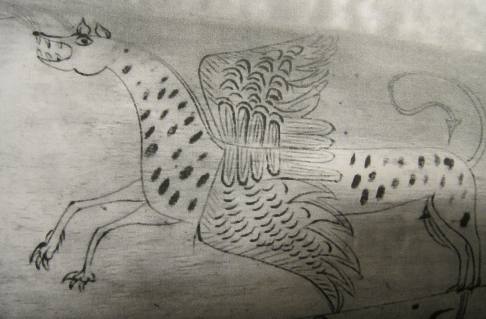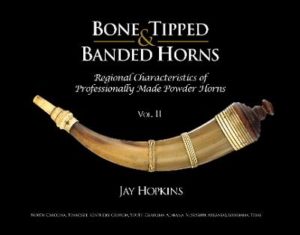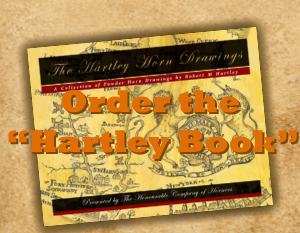Griffins or Hellhorses? by Billy Griner (from the February 2006 issue of The Horn Book)
July 12, 2010 by Bill Carter
Filed under Articles from the Archives
In preparation for Dixon’s, I was updating the inventory on past issues of The Horn Book and couldn’t help but peruse some of the old issues and realized, once again, that there are a plethora of articles that have some invaluable research. So I decided to change “The Horn Book Feature Article of the Month” to “Articles from the Archives” in hopes of generating more interest in past issues. To start this new segment I selected an article from the February 2006 issue entitled “Griffins or Hellhorses?” by Billy Griner. I hope you will enjoy this new segment. –Bill Carter
By the way, here is the link to purchase past issues of The Horn Book. >>Past Issues.
Griffins or Hellhorses?
By Billy Griner
Magical, mystical creatures are relatively commonplace as engravings on antique powder horns. It is not unusual to find a mermaid or fanciful serpent engraved alongside ships or even an angel tucked into the border work of an engraved powder horn. The list of magical creatures that came out of the imaginations of our forefathers is not long, but I believe these creatures are meaningful, because they reveal something of the spirit of the age.
One such mystical creature that shows up from time to time is what some have termed a “griffin.” This “griffin” does not appear on many antique horns. There are only eight known to exist. Two men are believed to have engraved all of them during the French and Indian War, between 1759-1761.
One look through Jim Dressler’s fine book, The Engraved Powder Horn, reveals illustrations of four different horns with what he and others have called a “griffin” engraved on them.
That “griffin” has puzzled me for some time. While looking at engraved features on other horns, there was no doubt what they were: unicorns looked like unicorns, angels looked like angels, and lions looked like lions. So why didn’t these “griffins” look like a griffin to me? A traditional griffin is half eagle and half lion. But the creatures that caught my attention looked more like a half dragon and half horse. I’m sorry, but it just did not look like a griffin to me at all.
It’s interesting how we connect the dots sometimes. I was reading one of my kid’s books from the Harry Potter series by J.K. Rowling and stumbled across a creature that she called a thestral. Her description of this creature instantly reminded me of the “griffin” on these old powder horns.
Rowling is known for using only creatures researched from mythology in her books. So, I began a lengthy search trying to tie down information concerning what Rowling called a thestral. I found that the word thestral is a twentieth century term used by science fiction and fantasy writers for a creature originally known as a hellhorse, demonsteed, or nytmare. These names come from a much older source – ancient Greek and Roman mythology.
In Greek mythology, hellhorses drew the chariot of Haides, the god of the underworld. In ancient Rome they were called Plutonian Demonsteeds, where they pulled the chariot of Pluto. Fire breathing steeds also drew the chariots of Ares (Greek) and Mars (Roman), the gods of war. Both the gods of war and the god of the underworld are associated with not only war and death, but also plague, pestilence, and fear. That the ancients viewed these steeds with awe and fear is a testament by the names they were given: “Murderous Ares came (to the battlefields of Troy)…Aithon (Red-Fire) and Phologeus (Flame), Konabos (Tumult) and Phobos (Panic-fear), his car-steeds, bare him down into the fight, the coursers which to roaring Boreas grim-eyed Erinnys bare, coursers that breathed life-blasting flame: groaned all shivering the air, as battleward they sped” (Quintus Smyrnaeus, Fall of Troy 8.239). The Romans called the horses of Mars “lovis Terrorque Pavorque…Fear and Dread (Valerius Flaccus, Ar. 3.89). Haides rode in his golden chariot drawn by the four hellhorses when he inflicted Thebes with plague as punishment for not allowing the burial of the dead warriors of the Army of the Seven against Thebes. Haides was also called “Plouton, master of the black-winged Oneiroi (dreams) by the Greeks.
So, what exactly is a hellhorse? A hellhorse is a member of the same group of mystical creatures that the Pegasus belongs to: That being winged horses or pegasui. But, of course, a hellhorse is no friendly Pegasus. According to Rich’s Pegopedia (a web site concerning winged horses throughout legend and myth) hellhorses are creatures “having the basic form of a horse, but are really more reptilian by nature. They have a sleek black/purple scaly hide, cloven hooves, a barbed tail like a dragon’s and a beaked snout, the forked tongue of a serpent, and tresses of fire for their mane, fetlocks and tail, and the ability to spit fire from their mouth. Hellhorses have the ability to fly, but not all require the addition of leathery winged appendages, like those of a bat, to do so.” Roughly the same description appears in several other bestiaries of mythological creatures on the internet.
In comparison, here are the shared features of the creature engraved by Cresey and the A. Cleveland – J. Carril carvers: the basic form is that of a horse with a scaly hide (rows of dots on the creature), cloven hooves, a barbed tail, and a forked tongue; they seem to be spitting fire, and of course they have wings for flight.
So, here is where I think the hellhorse connects with the eighteenth century colonial American mind. The engravers of these horns lived in a time where a classical education was normal. This included a significant exposure to Greek and Roman mythology in their studies. In fact, it was common to be tested on the mythology of the Greeks and Romans in order to gain admittance to colleges like Yale and Harvard. The horn carvers of the mid-eighteenth century were exposed directly or indirectly to the mythology of the Greek and Roman world. So the idea that an eighteenth century engraver would have known what a hellhorse was and what it represented is completely plausible.
Needless to say, the men who carried these horns were all survivors of war and pestilence. Easily the greatest killer of soldiers at Ft. Edward at that point in the war was smallpox. All of the original owners of the horns survived this “plague.” Could it be possible that the engravers were pointing out that the owners of these horns had lived through the hellish nightmare that was the outbreak of smallpox at Ft. Edward and Crown Point? Or could the figures have been engraved because these men had seen the horrific face of war? Had they metaphorically seen the god of war sweep over the field in his chariot being pulled by his murderous hellhorses, spreading death, fear, panic, and tumult, as well as plague and pestilence in his wake? All of the emotions of war seem to be represented by the hellhorse, demonstead, and nytemare.
While there is no direct reference that would say that the hellhorse as engraved on these powder horns represents anything more than the fancy of the engraver, to my mind, for the hellhorse to appear on all of these horns, a purpose for their repeated presence is demanded. I believe that the engravers of these horns carved the hellhorse on them as a reminder that each of these men had seen the nightmare of war and been very close to death, having witnessed the plague of small pox first hand, and lived.
Now, more than ever, I am confronted with one simple question. Just how much of what we see engraved on these antique powder horns has a meaning to the original owner that is lost on us? Our demythologized and secularized twenty-first century culture no longer places an emphasis on remembering Greek and Roman mythology, so most of us don’t. The hellhorse is a reminder, good or bad, of how far we have distanced ourselves from the mid-eighteenth century colonial American mind. ᾨ





